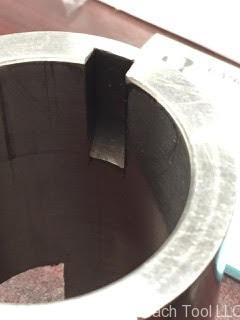Blind Keyway Relief Examples
Blind Keyway & Blind Spline Broaching
Broaching a blind keyway or blind spline is no longer a limitation for modern CNC shops. With CNC Broach Tools, you can machine precise internal features next to a shoulder or closed bore using your existing CNC lathe or mill — no expensive pull broach required. Blind broaching allows for complex part designs where a full through-bore isn’t possible, saving setup time and tooling costs.
Blind Keyway Relief Examples
The key to successful blind keyway broaching lies in proper relief design. We recommend a minimum undercut width of .250″, with the undercut diameter .030″ larger than the spline or keyway major diameter. This ensures chip clearance and prevents insert damage during retraction.
Blind Hole Broach vs. Blind Keyway Broach
A keyway is considered blind when it terminates inside the bore rather than breaking through. To successfully broach a blind keyway:
- The broach path must end “in air” with sufficient relief space.
- Always provide a groove or cross-hole relief for chip evacuation.
- The keyway must have enough clearance to prevent bottoming out the insert.
- When broaching from solid (bar stock), you are machining a blind keyway by default — even if it looks like a through bore.
Our carbide keyway inserts are designed to handle these blind conditions efficiently on both lathes and mills, with consistent cutting pressure and tool life.

CNC Mill Broaching A Blind Keyway
When cutting a blind keyway in a vertical mill, gravity works against you — chips tend to fall and pack into the relief area. To prevent crashes:
- We highly recommend a cross-hole relief when broaching a blind keyway in a vertical mill. This allows the coolant to flush the chips out the side of the part
- With a groove relief your chips can pack the groove, resulting in a crash
NOTE: We do not recommend that you taper or radius out of a blind keyway. This will result in a crash. You must have an adequate groove or cross-hole relief area
CNC Lathe Broaching a Blind Keyway
On a CNC lathe, gravity assists chip evacuation — but you’ll still need a proper groove or cross-hole relief.
- Ensure your groove diameter exceeds the keyway major diameter by at least .030″.
- Maintain sharp coolant flow to prevent chip compaction.
- Internal and external blind broaching are both possible using our carbide broach tools and toolholders.
Tips For Relief
- Make sure your cross-hole is larger than the keyway
- If your groove relief is not radially deeper than your keyway, you will “bottom out” and crash
- You will be programming the insert cutting edge to stop approximately .125” past the end of the keyway so that you do not decelerate in the keyway and create a taper
- Past this .080”, you need space for your chip to drop away without putting pressure back on the face of the insert
Blind Spline Broaching and Relief Design
CNC Broach Tools also enables blind spline broaching, allowing machinists to cut involute splines, SAE J500 serrations, and straight-sided splines near a shoulder or bottomed bore. This is especially useful for components like couplings, hubs, and transmission shafts where a through-bore isn’t possible.
To broach splines adjacent to a shoulder:
- Provide a minimum .125″-wide relief groove at the end of the spline form.
- Ensure the undercut diameter is .030″ larger than the spline major diameter.
- This applies to both internal and external splines following standards such as ANSI B92.1, B92.2M, DIN 5480, DIN 5482, and ISO 4156.
- Proper relief design ensures smooth deceleration and prevents insert breakage in blind spline applications.
Learn more about spline-specific broaching techniques in our article:
➡️ Mastering the Art of Broaching Involute Splines: A Guide for CNC Lathes and Mills
From Pull Broaches to CNC Broaching
Historically, broaching blind keyways or splines required large pull-broach machines with long, expensive tools dedicated to a single geometry. These machines were costly, slow to set up, and limited in flexibility.
With CNC spline and keyway broaching, shops can now perform the same operations on standard CNC mills or lathes using replaceable carbide inserts. This eliminates the need for heavy broaching presses, reduces tooling costs, and allows full control over the spline profile, relief, and finish — all within the same program.
 Contact Us
Contact Us (877) 248-1631
(877) 248-1631